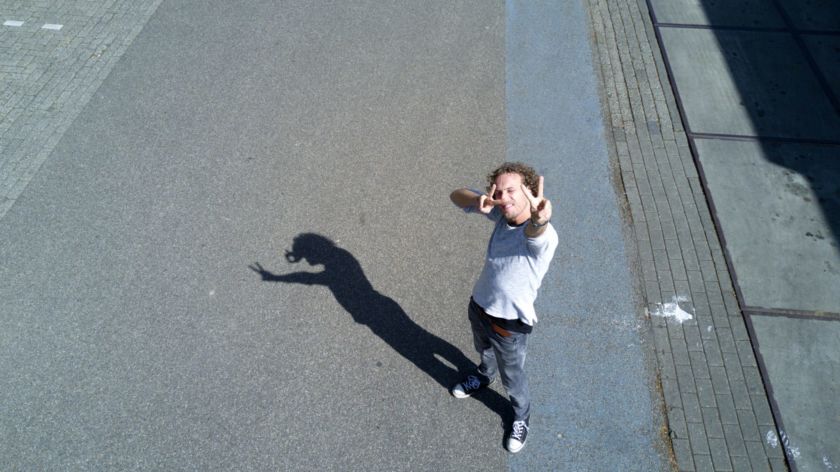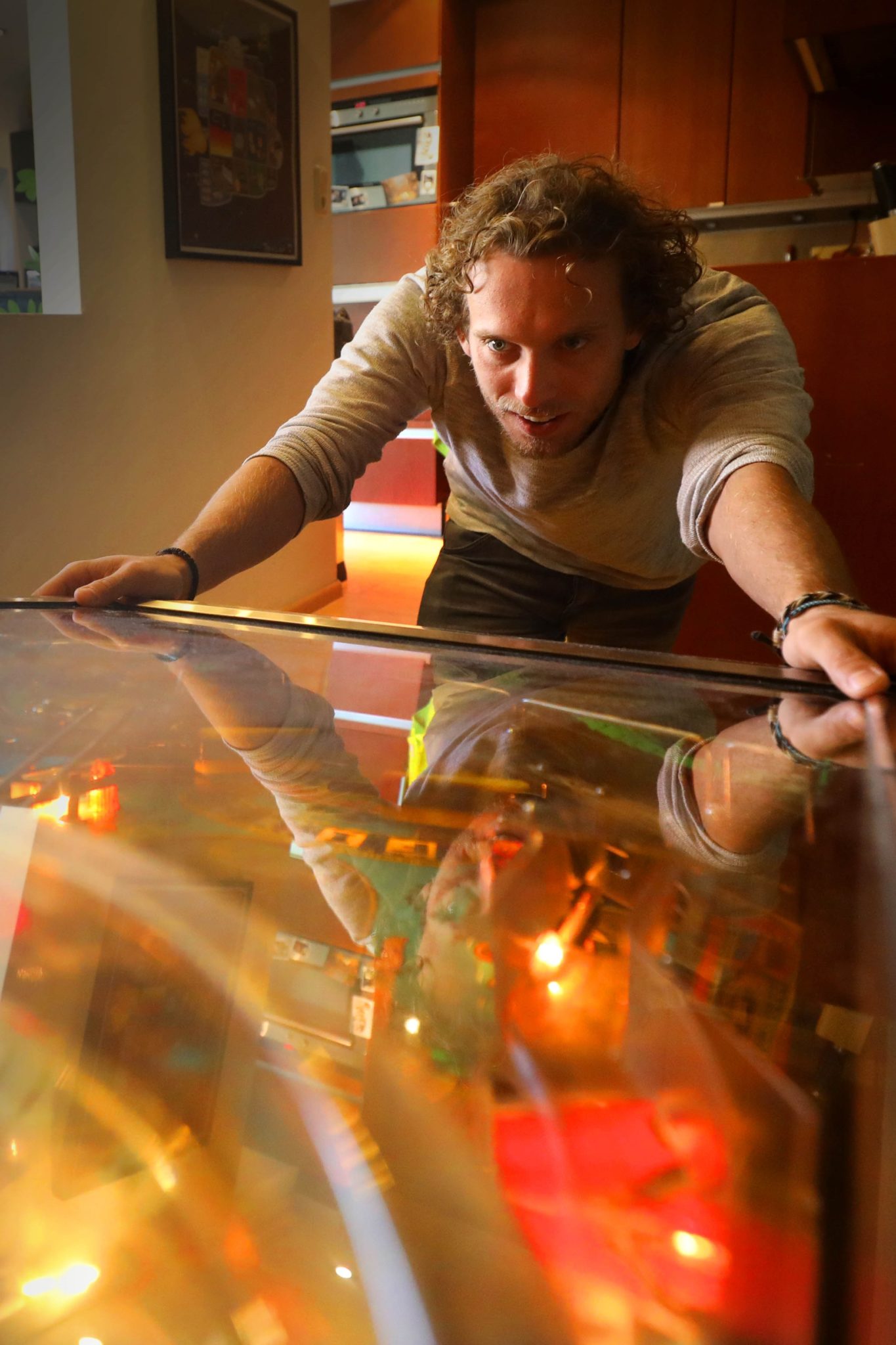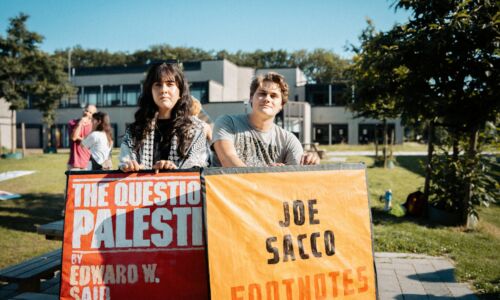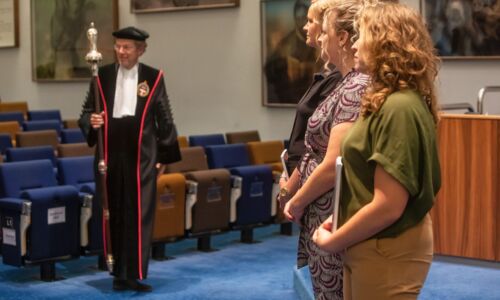Tim Smit just went ahead and did it: he made a movie
-
 Tim Smit. Foto: Gerard Verschooten
Tim Smit. Foto: Gerard Verschooten
In 2009, physics student Tim Smit created the short science-fiction film What’s in the Box. The visual effects were so incredible that in no time he had Hollywood on the line. Eight years later, his childhood dream is coming true: his very own feature film is to be released in Dutch cinemas today.
When Tim Smit (31) travels by train, he doesn’t see the landscape rushing past, but instead a dinosaur running along the tracks. Or an alien landing in a meadow. It was this talent for fantasy that led him in 2009 to create the nine-minute film What’s in the Box. The film showed a desolate industrial zone (parking area behind the Albert Heijn on the Daalseweg), abandoned cars, men in white suits, an exploding house, and an alien in the air. Dark and sinister. The visual effects were so convincing that the video attracted the attention of fans and experts. Smit, who was at the time studying Physics in Nijmegen, watched his film go viral. Before he knew it, he was on TV in De Wereld Draait Door, and film directors from Hollywood suddenly wanted his number. He actually peaked too soon, he told Vox at the time. He would have like to prepare the project better, with better technology behind both movie and drama.
‘I knew so little about the cinema industry; everything was new to me’
But if things had gone differently, he might never have had the contacts that allowed him to turn his movie into a real feature film, with in the lead Dan Stevens, currently in the cinemas as the beast in Beauty and the Beast. Nor could he have hooked Tygo Gernandt (Van God Los, Michiel de Ruyter) for the supporting role. Let alone convince the big shots in Hollywood that he, a physics student from a small town on the Rhine, was able to single-handedly direct a ninety-minute feature film.
That feature film is a childhood dream suddenly come true. With lots of luck and coincidence, but also with old-fashioned hard work. Too hard, in fact, since during production, Tim Smit suffered from a burnout. To recover, he travelled on his own for two months through Australia. His arms are tanned and his hair still blond from the sunshine. He has just returned to the apartment on the St. Annastraat where his studio is also located, in time for the opening of his movie, Kill Switch, on 1 June.
We are now in 2017, eight years after What’s in the Box went viral. Why did it take so long?
‘I knew so little about the cinema industry; everything was new to me. How was I supposed to choose between the Hollywood people who were interested? I had to hire people in the Netherlands to help me. Along the way I also switched partners a few times. In the end, I opted for the film company FilmNation, a young and creative company in Los Angeles. Together we hired an English script-writer and since we wanted to shoot in the Netherlands, CTM Entertainment in Hilversum became the producer. In the meantime, I also graduated and completed other projects: I created video clips and visual effects for other movies. In 2014 we were given the green light for the feature film and shooting could start.’
How did What’s in the Box go viral in 2009?
Tim Smit registered for a workshop at the GoShort film festival and was asked to send in some work. The test video for a dreamed-of movie feature that he was working on with his friend Thibaut Niels was nearly ready, so Smit went ahead and posted it on YouTube. He suspects people from the game scene might have been the first to notice it, because the atmosphere and sound effects in What’s in the Box strongly resemble the game Half Life. In the end, the video attracted 2.5 million viewers.
In Amsterdam, not in Nijmegen where What’s in the Box was shot. Why?
‘I really wanted to shoot it in Nijmegen! But it was too expensive to move the entire crew here – most of them are Amsterdam-based. It’s a low-budget movie: the entire project cost less than one million euros. And we only had eighteen days to shoot it, which is really short.’
Low budget? How so?
‘It’s an experimental film. Dutch science-fiction (English spoken, editors’ note) is not very common. Studio bosses don’t have big budgets for these kinds of projects. But I wasn’t doing it for the money, just for the opportunity. I am not only the director; I also created all the visual effects myself. For the actors this was sometimes difficult. In my head, I knew exactly how I wanted a scene to look, but they just saw an empty street. It’s a first-person sci-fi, which means it’s filmed from the perspective of the main character. I literally edited every shot on the computer – you can imagine how much work that was.’
Not really. Do tell.
‘We had shooting days of approximately eleven hours. Once shooting was over the actors would all go home, but I still had to work through all the material on my computer.’
Tim Smit stands up and walks towards a desk with three computers. This is his studio. He shows us a shot. An actor looks around. An empty frame, nothing to be seen. Then he pulls a layer over it: suddenly there is a wall on the waterfront. Next layer: skyscrapers on the horizon. Another layer: a foreboding overcast sky shot through with futuristic blue light. These effects are created by programming, which is where his knowledge of mathematics and physics comes in handy. You have to be able to make calculations. ‘Sometimes the computer is busy for days with a single calculation,’ says Smit. ‘So I was constantly stressed. Time was running short because I was supposed to deliver the edited shots. Like putting down railway tracks while the train is already moving.’

The mental burden of constant hurry and being busy with a single project in your head 24/7 ultimately led to his breakdown. ‘I had underestimated how difficult it would be. A good lesson for next time: not trying to do everything myself.’ Instead of outsourcing tasks, Smit worked harder and harder. Later he could see that he was suffering from a burn-out, but at the time, he just wanted to work quicker, because he thought he was not moving things on fast enough.
Smit is a busy young man. He talks fast, paces up and down in his black All Stars. He did not move to Los Angeles – although he did go there eight times for consultations – but kept his apartment in Nijmegen. ‘I love this city.’ His dark apartment on the ground floor of an old townhouse has a living-room with an open kitchen, a sleeping area behind a wall, and the three computers that form his studio. He picks up a Rubik’s cube from the mantelshelf and starts turning it in his hands. This is what he does for relaxation, games without zeroes and ones. It is also why he enjoys playing the two pinball machines next to the couch. ‘It’s great stuff, all physics!’ Gravity pulls the ball down, the mechanism does the rest. In his cupboard he also has Risk and technical Lego. A beautifully bound edition of Grimms’ fairy tales and novels by Stephen King. ‘That’s for inspiration.’ The Lonely Planet guide to Australia and New Zealand lies on top of the pile. In December 2016 the movie was completed, so he could finally do some travelling.
And? Do you feel rested now?
‘So so. I did have time to think everything through – which was much needed! – but in my mind I was still constantly busy with the movie.’
Have you watched it yet?
‘Far too often! I hate that. You keep seeing things that make you think: I could have done that so much better! Probably all directors feel that way.’
Are you nervous about the reviews?
‘Yes! This movie is not only my baby, it’s also my soul. I’ve worked on this project for eight years. It cost me blood, sweat and tears. I am so incredibly proud of it. Now other people get to see it too. It feels a bit like walking on the street naked. But there are bound to be negative reviews, and I can learn from them.’
The film Kill Switch will be released on 1 June in various Pathé cinemas and in LUX Nijmegen. It is a post-Apocalyptic story about an attempt to solve the energy crisis that is threatening to fail.



